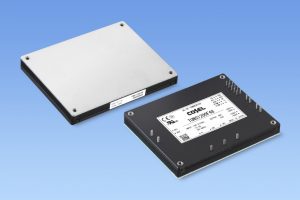Intended to partner home healthcare products, California-based TrumPower has released a family of medically-approved IP54 rated desktop ac-dc adaptors. Inputs range over 90 – 264Vac and 47 – 63Hz (drawing 2Arms at 115V and 1A at 230V). Power handling varies slightly with output voltage, spanning 132-150W across the family as voltage rating varies from 12V to 48V. Other output voltage options ...
Medical Electronics
Content related to medical electronics
3W dc-dc converters with 3kV isolation, 4:1 input range and 2MoOP
Cosel has announced a series of high isolation 3W dc-dc converters for medical and industrial applications. Isolation in the MH3 series is 3kVac and 4.2kVdc, and for medical applications the parts offer two means of operator protection (2x MoOP, 250Vac) isolation to IEC60601-1 3rd edition. There is a choice of input ranges, each spanning a 4:1 ratio: 4.5V – 18V ...
High-performance fabric sensors survive washing machine
Re-usable flexible medical skin electrodes have been built by combining fabric and chemical engineering at the University of Massachusetts Amherst. Technical performance is similar to commercial wet gel electrodes, while convenience is comparable to dry electrodes – which are easy to use but generally provide inferior signals to wet electrodes. Four of the electrodes have been built into a mask, and ...
1.2kW fan-free low profile ac-dc PSU for industrial and medical works at 100°C
Cosel has added a 1.2kW conduction-cooled ac-dc power supply to its TUNS series. For medical and industrial use, TUNS1200 is only 12.7mm high (117 x 87mm footprint) and weighs <280g. “TUNS1200 is suitable for applications requiring a silent power solution such as in a surgery room,” according to the company. “Equally, it is suitable for industrial applications when forced air ventilation is ...
750W medical power supply
Delta Electronics has added a 750W power supply to its MEB Series of medical enclosed power supplies – adding to existing 500W and 1,200W types. Called MEB-750A24, it comes in a 4 x 7 x 1.6inch (101 x 178 x 40mm) enclosure and provides a single 24V output with 5V 2A stand-by output. It can deliver full power from -20°C ...
Heart rate and oxygen sensor has LEDs and algorithms, in <1mm thickness
Maxim has created a module for sensing human heart-rate and oxygen saturation that includes photodiodes, an analogue front-end and a Arm Cortex-M4 microcontroller with embedded algorithms, in a thin (0.88mm) 4.5 x 4.1mm 38pin OLGA package. However, it does external component to operate: four LEDs, a multiplexer and an accelerometer chip. “MAXM86146 uses accelerometer data to compensate for periodic motion ...
Maxim adds ECC memory to Cortex-M4, and cuts power
Maxim has added error-code correction (ECC) to both flash, RAM and cache in a increased-reliability microcontroller for industrial, healthcare and IoT use. Called MAX32670, it is built around an Arm Cortex-M4 with floating-point unit, and this EEC is capable of single error correction and double error detection. “In many industrial and IoT applications, high energy particles and other environmental challenges present the danger ...
SK Telecom puts $20m into Nanox Imaging
SK Telecom will make an additional investment of $20 million in Nanox Imaging, an Israel-based medical imaging technology company, to become the second largest shareholder. SK Telecom initially invested $3 million in Nanox in 2019. As the first company to introduce commercial-grade digital X-ray technology based on a proprietary silicon MEMs semiconductor technology, Nanox developed the Nanox System, which is ...
THz radiation does affect skin, through absorption shock-waves
Researchers in Japan have discovered a mechanism by which THz radiation can cause biological changes several millimetres inside humans. This kind of electromagnetic radiation, at frequencies between microwaves and x-rays, is being considered as a less-invasive alternative to x-rays for medical and security scanning, and perhaps medical therapies for skin. THz radiation, which is technically difficult to generate, handle and receive, ...
What is COM-HPC?
COM-HPC is a computer-on-module standard for high-performance embedded computing, following on from COM Express 3.0. PICMG COM-HPC technical subcommittee chairman Christian Eder, also marketing manager at Congatec, and MD of embedded computing firm Recab UK Martin Frederiksen have put together a Q&A to explain further. What are the main differences between COM-HPC and COM Express? Eder: Computer-on-modules based on the ...
 Electronics Weekly Electronics Design & Components Tech News
Electronics Weekly Electronics Design & Components Tech News









